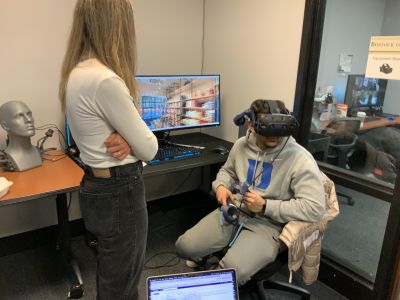Dr. Kusum Knapczyk (Senior Lecturer in Hindi)

If taking your students to the Taj Mahal isn't possible, why not bring the Taj Mahal to them? This concept inspired me to integrate VR into my class, allowing students to engage in meaningful conversations through role-plays. I designed role-plays for elementary and intermediate Hindi students to enhance their spoken Hindi and cultural competence. In this blog, I will explain step-by-step my role-play model that other instructors can adapt to successfully incorporate the much-needed technology, AI.
First, I decided what my elementary and intermediate students would need to talk about when they visit India. This list of conversation topics covered everything from ordering food at restaurants and asking for directions to taking an autorickshaw. For each conversation topic, I created a list of vocabulary and phrases they would need. I also thought about the props they might need. For example, for buying vegetables, I gave my students cut-outs of vegetables and real Indian money to practice their role-plays.
First, they practiced role-play with a partner. Then, I gave them a prompt which they needed to generate using AI. At first, they were surprised and asked me twice, "Are you asking us to use AI? Usually, instructors say not to use it." I said, "Yes, you are supposed to use AI to generate your role-plays." Students created their role-plays and shared them with me. In class, they presented their role-plays one by one, and I gave them feedback. They were able to see how AI generates the role-plays and what kind of mistakes it makes.
I indicated what kind of language they should not use when asking these questions and also pointed out the repetition of phrases such as "What is the price of X?" and "Your total is X." It was interesting to see how many different kinds of greetings and goodbyes AI uses in Hindi. This fosters linguistic skills and cultural awareness, engaging learners in meaningful, authentic communication.
These role-plays transformed my classes. Students were practicing conversations that were really useful for them, and they were learning phrases they could use. Students were never bored with these role-plays, even though they were on the same topic and generated through the same prompt. Students were thrilled to see how AI works, how accurately it tells the direction of places, and how accurately it can give the prices of things. For example, one time a student asked me what a good price for a banana was. It was difficult for students to assume the right price for a shirt or mango. They needed to know some rough estimates. AI does a good job by telling them a current realistic price. Students can also see how AI changes sentence structures, which is a good lesson for them that people don’t always say the same thing in the same way.
The icing on the cake was integrating Google Earth VR into the Hindi classroom to transform traditional teaching practices into immersive, hands-on experiences. Students virtually "visited" Indian landmarks, such as Khan Market, Jaipur palaces, and Prayagraj’s Mahakumbh Mela, engaging in guided role-plays like bargaining in markets or seeking directions. Students actively explored and experimented with the virtual environment, fostering collaboration through role-play interactions. Each session concluded with peer feedback and reflective discussions, reinforcing their linguistic and cultural observations while encouraging creative engagement.
This innovation aimed to enhance students' language proficiency and cultural awareness through experiential and immersive learning. The expected outcomes included improved conversational fluency, increased vocabulary retention, and a deeper understanding of Indian culture. By shifting from passive learning to active participation, the innovation added significant value to the course. Success was evaluated using pre- and post-assessments of students' speaking skills, alongside their feedback on engagement and confidence. The innovation effectively addressed the need for real-world conversational practice by offering students a creative and practical solution.
Other instructors can adapt this model by considering the necessary language, grammar, and vocabulary for their chosen role-plays. Students create these role-plays using AI, and the class discusses its strengths and weaknesses. This approach allows everyone to see different role-plays on the same topic. Providing a rubric helps students understand expectations. Students practice and perform role-plays in VR, with teachers incorporating cultural activities based on virtual observations. This innovation enhances engagement and contextual learning in less commonly taught languages (LCTLs). One student said, “It felt like I was really in India!” Another student said, "Why didn’t you do this in our previous classes?”